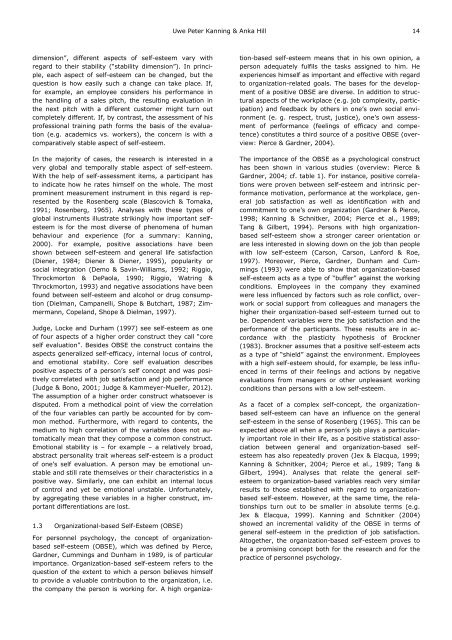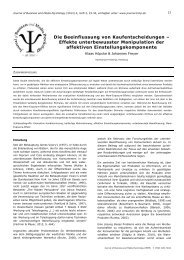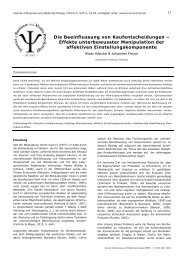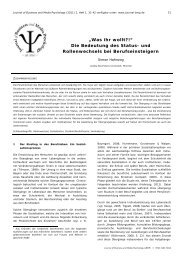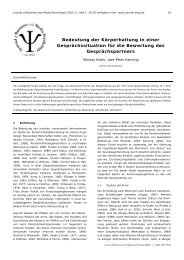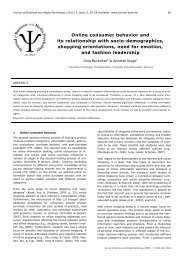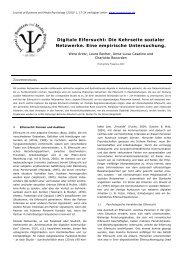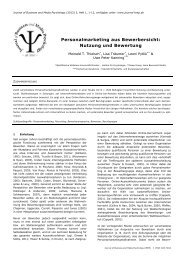Organization-based self-esteem scale – adaptation - Journal of ...
Organization-based self-esteem scale – adaptation - Journal of ...
Organization-based self-esteem scale – adaptation - Journal of ...
Create successful ePaper yourself
Turn your PDF publications into a flip-book with our unique Google optimized e-Paper software.
dimension”, different aspects <strong>of</strong> <strong>self</strong>-<strong>esteem</strong> vary with<br />
regard to their stability (“stability dimension”). In principle,<br />
each aspect <strong>of</strong> <strong>self</strong>-<strong>esteem</strong> can be changed, but the<br />
question is how easily such a change can take place. If,<br />
for example, an employee considers his performance in<br />
the handling <strong>of</strong> a sales pitch, the resulting evaluation in<br />
the next pitch with a different customer might turn out<br />
completely different. If, by contrast, the assessment <strong>of</strong> his<br />
pr<strong>of</strong>essional training path forms the basis <strong>of</strong> the evaluation<br />
(e.g. academics vs. workers), the concern is with a<br />
comparatively stable aspect <strong>of</strong> <strong>self</strong>-<strong>esteem</strong>.<br />
In the majority <strong>of</strong> cases, the research is interested in a<br />
very global and temporally stable aspect <strong>of</strong> <strong>self</strong>-<strong>esteem</strong>.<br />
With the help <strong>of</strong> <strong>self</strong>-assessment items, a participant has<br />
to indicate how he rates him<strong>self</strong> on the whole. The most<br />
prominent measurement instrument in this regard is represented<br />
by the Rosenberg <strong>scale</strong> (Blascovich & Tomaka,<br />
1991; Rosenberg, 1965). Analyses with these types <strong>of</strong><br />
global instruments illustrate strikingly how important <strong>self</strong><strong>esteem</strong><br />
is for the most diverse <strong>of</strong> phenomena <strong>of</strong> human<br />
behaviour and experience (for a summary: Kanning,<br />
2000). For example, positive associations have been<br />
shown between <strong>self</strong>-<strong>esteem</strong> and general life satisfaction<br />
(Diener, 1984; Diener & Diener, 1995), popularity or<br />
social integration (Demo & Savin-Williams, 1992; Riggio,<br />
Throckmorton & DePaola, 1990; Riggio, Watring &<br />
Throckmorton, 1993) and negative associations have been<br />
found between <strong>self</strong>-<strong>esteem</strong> and alcohol or drug consumption<br />
(Dielman, Campanelli, Shope & Butchart, 1987; Zimmermann,<br />
Copeland, Shope & Dielman, 1997).<br />
Judge, Locke and Durham (1997) see <strong>self</strong>-<strong>esteem</strong> as one<br />
<strong>of</strong> four aspects <strong>of</strong> a higher order construct they call “core<br />
<strong>self</strong> evaluation”. Besides OBSE the construct contains the<br />
aspects generalized <strong>self</strong>-efficacy, internal locus <strong>of</strong> control,<br />
and emotional stability. Core <strong>self</strong> evaluation describes<br />
positive aspects <strong>of</strong> a person’s <strong>self</strong> concept and was positively<br />
correlated with job satisfaction and job performance<br />
(Judge & Bono, 2001; Judge & Kammeyer-Mueller, 2012).<br />
The assumption <strong>of</strong> a higher order construct whatsoever is<br />
disputed. From a methodical point <strong>of</strong> view the correlation<br />
<strong>of</strong> the four variables can partly be accounted for by common<br />
method. Furthermore, with regard to contents, the<br />
medium to high correlation <strong>of</strong> the variables does not automatically<br />
mean that they compose a common construct.<br />
Emotional stability is <strong>–</strong> for example <strong>–</strong> a relatively broad,<br />
abstract personality trait whereas <strong>self</strong>-<strong>esteem</strong> is a product<br />
<strong>of</strong> one’s <strong>self</strong> evaluation. A person may be emotional unstable<br />
and still rate themselves or their characteristics in a<br />
positive way. Similarly, one can exhibit an internal locus<br />
<strong>of</strong> control and yet be emotional unstable. Unfortunately,<br />
by aggregating these variables in a higher construct, important<br />
differentiations are lost.<br />
1.3 <strong>Organization</strong>al-<strong>based</strong> Self-Esteem (OBSE)<br />
For personnel psychology, the concept <strong>of</strong> organization<strong>based</strong><br />
<strong>self</strong>-<strong>esteem</strong> (OBSE), which was defined by Pierce,<br />
Gardner, Cummings and Dunham in 1989, is <strong>of</strong> particular<br />
importance. <strong>Organization</strong>-<strong>based</strong> <strong>self</strong>-<strong>esteem</strong> refers to the<br />
question <strong>of</strong> the extent to which a person believes him<strong>self</strong><br />
to provide a valuable contribution to the organization, i.e.<br />
the company the person is working for. A high organiza-<br />
Uwe Peter Kanning & Anka Hill 14<br />
tion-<strong>based</strong> <strong>self</strong>-<strong>esteem</strong> means that in his own opinion, a<br />
person adequately fulfils the tasks assigned to him. He<br />
experiences him<strong>self</strong> as important and effective with regard<br />
to organization-related goals. The bases for the development<br />
<strong>of</strong> a positive OBSE are diverse. In addition to structural<br />
aspects <strong>of</strong> the workplace (e.g. job complexity, participation)<br />
and feedback by others in one’s own social environment<br />
(e. g. respect, trust, justice), one’s own assessment<br />
<strong>of</strong> performance (feelings <strong>of</strong> efficacy and competence)<br />
constitutes a third source <strong>of</strong> a positive OBSE (overview:<br />
Pierce & Gardner, 2004).<br />
The importance <strong>of</strong> the OBSE as a psychological construct<br />
has been shown in various studies (overview: Pierce &<br />
Gardner, 2004; cf. table 1). For instance, positive correlations<br />
were proven between <strong>self</strong>-<strong>esteem</strong> and intrinsic performance<br />
motivation, performance at the workplace, general<br />
job satisfaction as well as identification with and<br />
commitment to one’s own organization (Gardner & Pierce,<br />
1998; Kanning & Schnitker, 2004; Pierce et al., 1989;<br />
Tang & Gilbert, 1994). Persons with high organization<strong>based</strong><br />
<strong>self</strong>-<strong>esteem</strong> show a stronger career orientation or<br />
are less interested in slowing down on the job than people<br />
with low <strong>self</strong>-<strong>esteem</strong> (Carson, Carson, Lanford & Roe,<br />
1997). Moreover, Pierce, Gardner, Dunham and Cummings<br />
(1993) were able to show that organization-<strong>based</strong><br />
<strong>self</strong>-<strong>esteem</strong> acts as a type <strong>of</strong> “buffer” against the working<br />
conditions. Employees in the company they examined<br />
were less influenced by factors such as role conflict, overwork<br />
or social support from colleagues and managers the<br />
higher their organization-<strong>based</strong> <strong>self</strong>-<strong>esteem</strong> turned out to<br />
be. Dependent variables were the job satisfaction and the<br />
performance <strong>of</strong> the participants. These results are in accordance<br />
with the plasticity hypothesis <strong>of</strong> Brockner<br />
(1983). Brockner assumes that a positive <strong>self</strong>-<strong>esteem</strong> acts<br />
as a type <strong>of</strong> “shield” against the environment. Employees<br />
with a high <strong>self</strong>-<strong>esteem</strong> should, for example, be less influenced<br />
in terms <strong>of</strong> their feelings and actions by negative<br />
evaluations from managers or other unpleasant working<br />
conditions than persons with a low <strong>self</strong>-<strong>esteem</strong>.<br />
As a facet <strong>of</strong> a complex <strong>self</strong>-concept, the organization<strong>based</strong><br />
<strong>self</strong>-<strong>esteem</strong> can have an influence on the general<br />
<strong>self</strong>-<strong>esteem</strong> in the sense <strong>of</strong> Rosenberg (1965). This can be<br />
expected above all when a person’s job plays a particularly<br />
important role in their life, as a positive statistical association<br />
between general and organization-<strong>based</strong> <strong>self</strong><strong>esteem</strong><br />
has also repeatedly proven (Jex & Elacqua, 1999;<br />
Kanning & Schnitker, 2004; Pierce et al., 1989; Tang &<br />
Gilbert, 1994). Analyses that relate the general <strong>self</strong><strong>esteem</strong><br />
to organization-<strong>based</strong> variables reach very similar<br />
results to those established with regard to organization-<br />
<strong>based</strong> <strong>self</strong>-<strong>esteem</strong>. However, at the same time, the relationships<br />
turn out to be smaller in absolute terms (e.g.<br />
Jex & Elacqua, 1999). Kanning and Schnitker (2004)<br />
showed an incremental validity <strong>of</strong> the OBSE in terms <strong>of</strong><br />
general <strong>self</strong>-<strong>esteem</strong> in the prediction <strong>of</strong> job satisfaction.<br />
Altogether, the organization-<strong>based</strong> <strong>self</strong>-<strong>esteem</strong> proves to<br />
be a promising concept both for the research and for the<br />
practice <strong>of</strong> personnel psychology.


